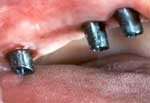Replacing Several Teeth
Replacing Several Teeth
The purpose of this section is to provide patients with options for replacing several teeth.
Patients who are missing several teeth may choose to replace the teeth with an implant supported bridge. Another option is to replace each missing tooth with a dental implant that provides the most natural appearance.
What are the advantages of implant supported bridges over fixed bridges or removable partial dentures?
There are many options for replacing missing teeth, but bridges supported by implants provide several advantages over other options. In addition to looking and performing like natural teeth, implant supported bridges replace teeth without support from adjacent natural teeth. Other common treatments for the loss of several teeth, such as fixed bridges or removable partial dentures, are dependent on support from adjacent teeth.
In addition, implant supported bridges will replace some of your tooth roots and therefore better preserve your jaw bone. With a fixed bridge or removable partial denture, the bone that previously surrounded the tooth root may begin to resorb (deteriorate). Dental implants integrate with your jawbone, helping to keep the bone healthy and intact.
In the long term, implants are esthetic, functional and comfortable. Gums and bone can recede around a fixed bridge or removable partial denture, leaving a visible defect. Resorbed bone beneath bridges or removable partial dentures can lead to a collapsed, unattractive smile. The cement holding bridges in place can wash out, allowing bacteria to decay teeth that anchor the bridge. In addition, removable partial dentures can move around in the mouth and reduce your ability to eat certain foods.
How will the implants be placed?
The first step after tooth extraction is to place an implant, which looks like a screw, into your jaw. Over the next two to six months, the bone bonds with the implant to make a strong anchor for your future crown (tooth). You will have a temporary tooth during this healing process.
 After the bone heals around the dental implant, your periodontist often has to uncover the implant and add small attaching pieces, called abutments, on which the new tooth will be placed. Your gums will need a few weeks to heal following this procedure.
After the bone heals around the dental implant, your periodontist often has to uncover the implant and add small attaching pieces, called abutments, on which the new tooth will be placed. Your gums will need a few weeks to heal following this procedure.
Sometimes the periodontist does not need to place abutments because some implant systems already include the pieces. Your periodontist will advise you on which system is best for you.
 Finally, replacement teeth, or bridges, will be created for you by your dentist and attached to the abutments. After a short time, you will experience restored confidence in your smile and your ability to chew and speak.
Finally, replacement teeth, or bridges, will be created for you by your dentist and attached to the abutments. After a short time, you will experience restored confidence in your smile and your ability to chew and speak.